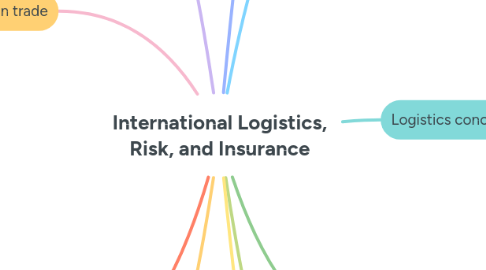
1. Claims and procedures
1.1. Claims for loss or damage to shipment on transit can be claimed from carriers or insurers. Most cargo claims are settled with insurance companies.
1.1.1. Preliminary notice of claim
1.1.2. formal notice and settlement.
2. Risks in foreign trade
2.1. Political risks
2.1.1. Actions of government authorities, war, revolution, terrorism, strikes
2.1.2. Managing political risk
2.1.2.1. Monitoring political developments, insuring against political risks
2.2. Foreign credit risk
2.2.1. Risks of buyer’s default or delay in payment.
2.2.2. Managing foreign credit risk
2.2.2.1. Appropriate credit management, letter of credit and other conditions, insurance
2.3. Foreign exchange risk
2.3.1. Changes in currency values that could reduce future exporter’s receipts or increase importer’s payments in foreign currency
2.3.2. Managing foreign exchange risk:
2.3.2.1. Shifting the risk to the other party or to third parties.
2.4. Transportation risk
2.4.1. Loss or damage to merchandise during transit.
3. External influences on logistics decisions
3.1. Regulations
3.1.1. Export controls, tariffs, nontariff barriers, privatization and deregulation of transportation and communications
3.2. Competition
3.2.1. Competitive pressures on firms to examine logistics systems
3.3. Technology
3.3.1. Enables importers to know the date of shipment, location of cargo on transit, and expected date of arrival. It also handles other logistics functions.
4. Importance of logistics to international trade
4.1. Efficient allocation of resources
4.2. Expansion of economic growth and employment.
5. Logistics
5.1. The process of planning, implementing, and controlling the fl ow and storage of materials from the point of origin to the point of consumption.
5.1.1. Two categories of logistics
5.1.1.1. Materials management: The timely movement of materials from sources of supply to point of manufacture, assembly, or distribution
5.1.1.2. Physical distribution: Movement of a firm’s products to consumers.
6. Differences between Domestic and International Logistics
6.1. Domestic logistics
6.1.1. Domestic currency used
6.1.2. One national regulation on customs procedures, documentation, packaging, and labeling requirements
6.1.3. Most goods transported by truck or rail
6.1.4. Generally, short distances, short lead times, and small inventory levels
6.2. International logistics
6.2.1. Different currency and exchange rates
6.2.2. Different national regulations and many intermediaries participating in the distribution channel
6.2.3. Most goods transported by air or sea
6.2.4. Long distances, longer lead times, and the need for higher inventory levels
7. Logistics concepts
7.1. The systems approach: Emphasis on maximizing benefi ts of the corporate system as a whole as opposed to that of individual units.
7.2. The total-cost approach
7.3. The opportunity-cost approach
8. Logistics functions
8.1. Labeling
8.2. packing
8.3. traffic management
8.4. inventory
8.5. storage
9. Insurance
9.1. The principle of insurable interest
9.1.1. A financial interest based on some legal right in the preservation of the insured property
9.2. The principle of subrogation
9.2.1. On paying the insured’s claim, the insurer stands in the position of the former (the insured) to claim from other parties who are responsible for the loss or damage
10. Marine insurance
10.1. Perils-only policy
10.1.1. Coverage for cargo loss/damage
10.1.1.1. Free of particular average (FPA)
10.1.1.1.1. Policy covers total loss and partial loss from certain specifi ed risks insured against
10.1.1.2. Within average policy (WA)
10.1.1.2.1. Policy covers total loss and partial losses greater than a given percentage and insurer liable for the total amount lost
10.2. All-risks policy
10.2.1. Covers the broadest level of coverage except for those expressly excluded in the policy
